Hospital for Officers
Military
At the outbreak of WW1 the Fishmongers' Hall, owned by one of the twelve ancient Great Livery Companies of the City of London, was converted into a hospital for the wounded. It was the first time in any war, it was claimed, that such an event had occurred.
The wives of the aldermen of several electoral wards had approached many City firms with the idea, and their generosity enabled the City branch of the British Red Cross Society to establish the Hospital.
The Royal Red Cross Hospital for Officers was officially opened on 1st October 1914 by the Lord Mayor of London. It had 27 beds.
Only the spacious apartments on the first floor of the building were used. The Great Hall, with its gilded walls and ceiling, was subdivided by wooden partitions, 7' 6" (2.3 metres) high and painted white, to form five cubicles, each with two beds. The cubicles occupied the side of the room with windows, with the other half of the Hall left free, except for a cubicle for Matron's room. A smaller room overlooking the river was divided into two rooms, each with two beds. Another room had three cubicles with two beds in each. Green cork carpet covered the floors of the wards and landings. The balcony contained a wooden hut, erected for septic cases and for those needing open air treatment - the patients were literally lying over the river. At the back of the building was a room with three single-bedded cubicles; away from the sound of river traffic noise, this was used for the reception of seriously wounded cases. Smaller apartments housed the X-ray Department, the operating theatre and anaesthetising room.
Each cubicle was distinctly home-like, with its furnishings like those of a private house rather than a public institution. Each one had armchairs, as well as a reading table and an electric light. The beds were covered with down quilts with pink rugs beside. Warmth was provided by electric radiators.
The medical staff was provided by St Bartholomew's Hospital. The nursing staff consisted of a Matron, eight Sisters from St John's House and fully trained Red Cross nurses. Voluntary Aid Detachments supplied the probationer and domestic staff, under the supervision of their own superior officer.
The kitchen was situated in the basement but, as a lift could not be installed, the Fishmongers' Company lent the services of the men who carried the dishes at the periodic banquets to transport the food to the wards. As it was a small hospital, Matron preferred the patients to take their meals in their own rooms rather than in a common dining room. The patients were allowed to entertain two guests for afternoon tea, if they so desired.
In November 1914 the King and Queen visited the Hospital, speaking to each patient.
The Hospital closed in August 1917 with 30 beds. By that time more than 800 patients had been treated there and more than 250 operations been performed in the small operating theatre.
Present status (April 2010)
The Fishmongers' Hall, rebuilt in 1835, suffered some bomb damage during WW2 but had been completely restored by 1954. It remains a venue for banquets and conferences.
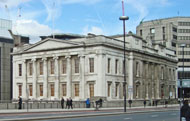
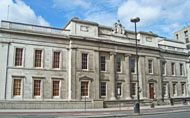
Fishmongers' Hall, as seen from London Bridge.
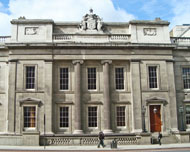
The central section of the London Bridge elevation.
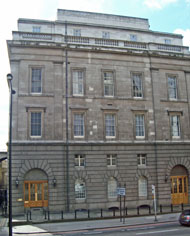
The building, as seen from Upper Thames Street.
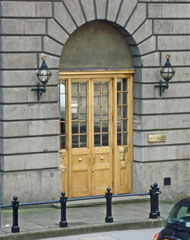
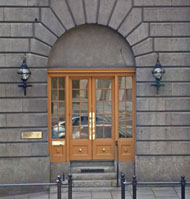
The entrance doorways in Upper Thames Street.

The building, as seen approaching London Bridge along King William Street.
(Author unstated) 1914 An Officers' Hospital in the City of London. British Medical Journal 2 (2806), 645.
(Author unstated) 1914 The City of London and the wounded. British Journal of Nursing, 10th October, 288.
(Author unstated) 1917 Fishmongers' Hall Hospital. British Journal of Nursing, 5th May, 307
http://rcnarchive.rcn.org.uk (November 1914)
http://rcnarchive.rcn.org.uk (August 1917)
Return to home page